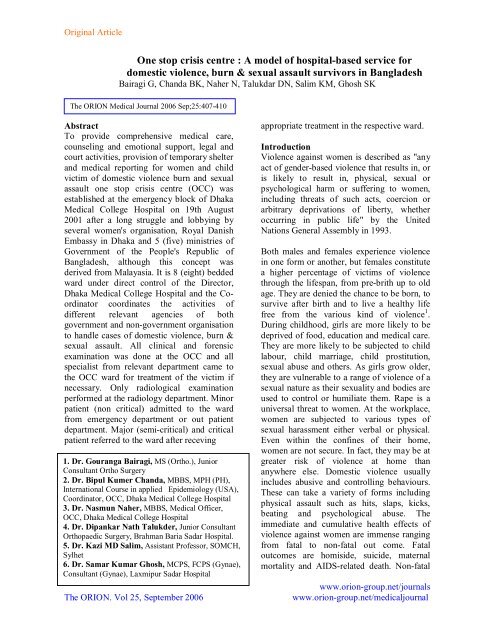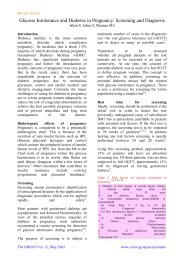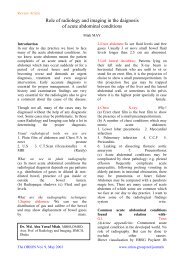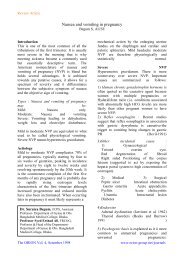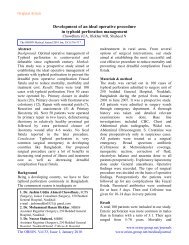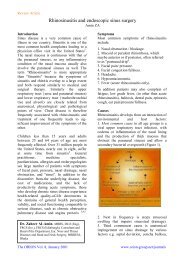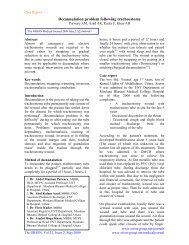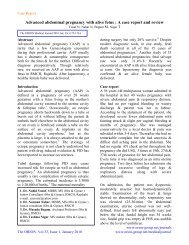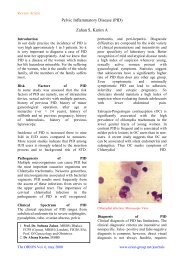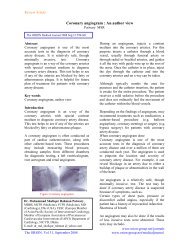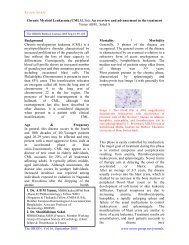One stop crisis centre : A model of hospital-based ... - Orion Group
One stop crisis centre : A model of hospital-based ... - Orion Group
One stop crisis centre : A model of hospital-based ... - Orion Group
Create successful ePaper yourself
Turn your PDF publications into a flip-book with our unique Google optimized e-Paper software.
Original Article<br />
<strong>One</strong> <strong>stop</strong> <strong>crisis</strong> <strong>centre</strong> : A <strong>model</strong> <strong>of</strong> <strong>hospital</strong>-<strong>based</strong> service for<br />
domestic violence, burn & sexual assault survivors in Bangladesh<br />
Bairagi G, Chanda BK, Naher N, Talukdar DN, Salim KM, Ghosh SK<br />
The ORION Medical Journal 2006 Sep;25:407-410<br />
Abstract<br />
To provide comprehensive medical care,<br />
counseling and emotional support, legal and<br />
court activities, provision <strong>of</strong> temporary shelter<br />
and medical reporting for women and child<br />
victim <strong>of</strong> domestic violence burn and sexual<br />
assault one <strong>stop</strong> <strong>crisis</strong> <strong>centre</strong> (OCC) was<br />
established at the emergency block <strong>of</strong> Dhaka<br />
Medical College Hospital on 19th August<br />
2001 after a long struggle and lobbying by<br />
several women's organisation, Royal Danish<br />
Embassy in Dhaka and 5 (five) ministries <strong>of</strong><br />
Government <strong>of</strong> the People's Republic <strong>of</strong><br />
Bangladesh, although this concept was<br />
derived from Malayasia. It is 8 (eight) bedded<br />
ward under direct control <strong>of</strong> the Director,<br />
Dhaka Medical College Hospital and the Coordinator<br />
coordinates the activities <strong>of</strong><br />
different relevant agencies <strong>of</strong> both<br />
government and non-government organisation<br />
to handle cases <strong>of</strong> domestic violence, burn &<br />
sexual assault. All clinical and forensic<br />
examination was done at the OCC and all<br />
specialist from relevant department came to<br />
the OCC ward for treatment <strong>of</strong> the victim if<br />
necessary. Only radiological examination<br />
performed at the radiology department. Minor<br />
patient (non critical) admitted to the ward<br />
from emergency department or out patient<br />
department. Major (semi-critical) and critical<br />
patient referred to the ward after receving<br />
1. Dr. Gouranga Bairagi, MS (Ortho.), Junior<br />
Consultant Ortho Surgery<br />
2. Dr. Bipul Kumer Chanda, MBBS, MPH (PH),<br />
International Course in applied Epidemiology (USA),<br />
Coordinator, OCC, Dhaka Medical College Hospital<br />
3. Dr. Nasmun Naher, MBBS, Medical Officer,<br />
OCC, Dhaka Medical College Hospital<br />
4. Dr. Dipankar Nath Talukder, Junior Consultant<br />
Orthopaedic Surgery, Brahman Baria Sadar Hospital.<br />
5. Dr. Kazi MD Salim, Assistant Pr<strong>of</strong>essor, SOMCH,<br />
Sylhet<br />
6. Dr. Samar Kumar Ghosh, MCPS, FCPS (Gynae),<br />
Consultant (Gynae), Laxmipur Sadar Hospital<br />
The ORION. Vol 25, September 2006<br />
appropriate treatment in the respective ward.<br />
Introduction<br />
Violence against women is described as "any<br />
act <strong>of</strong> gender-<strong>based</strong> violence that results in, or<br />
is likely to result in, physical, sexual or<br />
psychological harm or suffering to women,<br />
including threats <strong>of</strong> such acts, coercion or<br />
arbitrary deprivations <strong>of</strong> liberty, whether<br />
occurring in public life" by the United<br />
Nations General Assembly in 1993.<br />
Both males and females experience violence<br />
in one form or another, but females constitute<br />
a higher percentage <strong>of</strong> victims <strong>of</strong> violence<br />
through the lifespan, from pre-brith up to old<br />
age. They are denied the chance to be born, to<br />
survive after birth and to live a healthy life<br />
free from the various kind <strong>of</strong> violence 1 .<br />
During childhood, girls are more likely to be<br />
deprived <strong>of</strong> food, education and medical care.<br />
They are more likely to be subjected to child<br />
labour, child marriage, child prostitution,<br />
sexual abuse and others. As girls grow older,<br />
they are vulnerable to a range <strong>of</strong> violence <strong>of</strong> a<br />
sexual nature as their sexuality and bodies are<br />
used to control or humiliate them. Rape is a<br />
universal threat to women. At the workplace,<br />
women are subjected to various types <strong>of</strong><br />
sexual harassment either verbal or physical.<br />
Even within the confines <strong>of</strong> their home,<br />
women are not secure. In fact, they may be at<br />
greater risk <strong>of</strong> violence at home than<br />
anywhere else. Domestic violence usually<br />
includes abusive and controlling behaviours.<br />
These can take a variety <strong>of</strong> forms including<br />
physical assault such as hits, slaps, kicks,<br />
beating and psychological abuse. The<br />
immediate and cumulative health effects <strong>of</strong><br />
violence against women are immense ranging<br />
from fatal to non-fatal out come. Fatal<br />
outcomes are homiside, suicide, maternal<br />
mortality and AIDS-related death. Non-fatal<br />
www.orion-group.net/journals<br />
www.orion-group.net/medicaljournal
Original Article<br />
outcomes comprising permanent disabilities,<br />
unwanted and complicated pregnancies, HIV<br />
and other sexually transmitted infections<br />
(STIS), depression, anxiety, chronic pain<br />
syndrome, suicidal thoughts etc 2 .<br />
Overview <strong>of</strong> violence in Bangladesh<br />
According to Bangladesh National Women<br />
Lawyers Association (BNWLA) violence<br />
against women in Bangladesh in the year<br />
2001 there are 530 reported cases <strong>of</strong> domestic<br />
violence, 370 cases <strong>of</strong> rape, 327 cases <strong>of</strong><br />
murder, 140 cases <strong>of</strong> suicide, 122 cases <strong>of</strong><br />
kidnapping, 146 cases <strong>of</strong> unnatural death 3 .<br />
The actual numbers are vague but speculated<br />
to be higher. The statistical chart shown<br />
below.<br />
Type <strong>of</strong> Violence<br />
Total<br />
Rape 370<br />
Murder 327<br />
Suicide 140<br />
Kidnapping 122<br />
Unnatural death 146<br />
Violence against women in Bangladesh (January-<br />
December 2001)<br />
Type <strong>of</strong> Violence<br />
Total<br />
Murder for dowry 173<br />
Suicide 281<br />
Torture 76<br />
Wife beating<br />
Data not<br />
Incest<br />
avialable<br />
Polygamy<br />
Outbreak <strong>of</strong> domestic violence in 2001<br />
The fight to uphold the rights <strong>of</strong> women by<br />
countering violence and discrimination<br />
against them is not without years <strong>of</strong> struggle<br />
and lobbying by women's (Naripokkho,<br />
BNWLA & Ain O Shalish Kendra) activists<br />
for social justice.<br />
The birth <strong>of</strong> one <strong>stop</strong> <strong>crisis</strong> <strong>centre</strong> (OCC)<br />
Many battered women and victim <strong>of</strong> rape find<br />
hope at the OCC located at the emergency<br />
block <strong>of</strong> Dhaka Medical College Hospital,<br />
which operates 24 hours. It is a safe and<br />
secured place for survivors <strong>of</strong> domestic<br />
The ORION. Vol 25, September 2006<br />
violence, rape or child abuse seeking medical<br />
treatment, medical report for legal proceeding<br />
or shelter.<br />
The establishment <strong>of</strong> such <strong>centre</strong> was justified<br />
in 1999 when emergency department in short<br />
carried out a short study on the epidemiology<br />
<strong>of</strong> domestic violence and nature <strong>of</strong> its injuries.<br />
Out <strong>of</strong> 100 cases analysis revealed that 50<br />
percent <strong>of</strong> women were pushed or slapped, 20<br />
percent were attacked with weapon, 16<br />
percent were kicked, 8 percent were beaten<br />
and 6 percent were throttled. At that time<br />
emergency department was handling an<br />
average <strong>of</strong> 20 cases per month.<br />
The survey shows significant number <strong>of</strong> cases<br />
but weaknesses in the system did not provide<br />
care to the needs <strong>of</strong> the women. For this<br />
reason multi-sectoral, Multi-disciplinary,<br />
inter-agency teamwork combined with<br />
various efforts <strong>of</strong> the intra-<strong>hospital</strong> team was<br />
proposed to manage survivors <strong>of</strong> violence and<br />
this resulted in the establishment <strong>of</strong> the first<br />
Bangladesh OCC as a seperate department <strong>of</strong><br />
Dhaka Medical College Hospital in the<br />
emergency block in August 19, 2001.<br />
Establishment <strong>of</strong> "<strong>One</strong> Stop Crisis Centre" in<br />
Dhaka Medical College Hospital and<br />
Rajshahi Medical College Hospital to provide<br />
women & child survivors <strong>of</strong> violence with<br />
comprehensive medical care, counselling,<br />
reporting <strong>of</strong> crime and related investigation<br />
was brought into light by combined effort <strong>of</strong><br />
Naripokkho, Royal Danish Embassy in Dhaka,<br />
Ministry <strong>of</strong> Women & Child Affais, Health &<br />
Family Welfare, Home Affairs, Social<br />
Welfare & Information. Although this<br />
concept has been pioneered in Malaysia by Dr.<br />
Abu Hassan Asaari Bin Abdullah, Senior<br />
consultant Traumatalogist and Head <strong>of</strong><br />
emergency department, Kuala Lumpur<br />
General Hospital Malaysia, it begun to work<br />
in DMCH on 19th August 2001 4 .<br />
Concept and philosophy <strong>of</strong> OCC<br />
The OCC is <strong>based</strong> on the concept <strong>of</strong><br />
"Integrated and coordinated teamwork <strong>of</strong><br />
multi-sectoral and inter-agency network for<br />
the management <strong>of</strong> survivors <strong>of</strong> violence<br />
www.orion-group.net/journals<br />
www.orion-group.net/medicaljournal
Original Article<br />
against women and children". Its objctives are<br />
to serve the survivors <strong>of</strong> violence in<br />
identification and diagnosis, therapeutic and<br />
medical care, counselling and emotional<br />
support, multi-level <strong>crisis</strong> intervention, legal<br />
and court activities, provision <strong>of</strong> temporary<br />
shelter and medical reporting 5 .<br />
Structure <strong>of</strong> OCC<br />
The physical set-up <strong>of</strong> the OCC comprises<br />
four areas. In the first area comprises eight<br />
bedded ward where the patient are admitted<br />
from emergency department or outpatient<br />
department or referred from other wards. The<br />
second area is the room for doctors, police<br />
<strong>of</strong>ficers and computer programmer. The third<br />
section is forensic examination room. lastly<br />
the counselling room. The infrastructure <strong>of</strong><br />
the OCC is set-up in a manner to provide<br />
survivors, privacy, comfort, safety and<br />
security besides serving the objectives <strong>of</strong> the<br />
OCC. It is round the clock 24 hour<br />
operational hours and locations with in the<br />
emergency service area with resuscitation<br />
facilites are also appropriate.<br />
SI.No Designation No.s<br />
1 Medical <strong>of</strong>ficer 03<br />
2 Sub-inspector <strong>of</strong> police 02<br />
3 Senior staff nurse 04<br />
4 Computer programmer 01<br />
5 Police constable 02<br />
6 Cleaner/Peon 03<br />
Existing human resource in OCC<br />
All the staffs <strong>of</strong> OCC are deputed from<br />
respective ministries and only cleaners/peon<br />
are daily basis worker recruited by Project<br />
Implemtation unit (MSP-VAW). The <strong>One</strong>-<br />
Stop Crisis Centre is under direct control <strong>of</strong><br />
Director, Dhaka Medical College Hospital<br />
and senior most Medical Officer will act as<br />
Co-ordinator <strong>of</strong> OCC.<br />
Management <strong>of</strong> OCC<br />
Management strategies are <strong>based</strong> on need<br />
where services are patient focused and all<br />
services for total patient care come to the<br />
ward. Patient need not go to the different<br />
places. OCC has succeeded in drawing public<br />
The ORION. Vol 25, September 2006<br />
Forensic<br />
Burn &<br />
Plastic<br />
Surgery<br />
Social<br />
Welfare<br />
confidence because the survivors come for<br />
help at the <strong>centre</strong>. Before the establishment <strong>of</strong><br />
the <strong>centre</strong> many survivors were hesitant to<br />
come forward due to the tedious, painful and<br />
emotional process involved. Now they can<br />
approach the <strong>centre</strong> and appropriate actions<br />
will be taken. This is an important milestone<br />
for the OCC (Shown in box-01).<br />
NGOS<br />
BNWLA<br />
Naripokkho<br />
GO's<br />
Ministry <strong>of</strong> Health &<br />
Family- Welfare,<br />
Ministry <strong>of</strong> Home<br />
Ministry <strong>of</strong> Social<br />
Welfare<br />
Ministry <strong>of</strong> Information<br />
Ministry <strong>of</strong> Children &<br />
Womenaffairs (Lead<br />
Ministry)<br />
Intra-<strong>hospital</strong><br />
team<br />
Emergency &<br />
Trumadepartment<br />
(Casualty)<br />
Forensic<br />
department<br />
Burn & Plastic<br />
surgery<br />
Obstetrics and<br />
Gynocologydepartment<br />
Radiology<br />
department<br />
Social welfare and<br />
Others relevant<br />
department<br />
Box -01 : Multi-sectoral support <strong>of</strong> OCC<br />
Working committee<br />
OCC operates on collaboration among<br />
governmental and non-governmental<br />
organisation and with a working committee<br />
representing the various agencies (Box-02).<br />
Intra-<strong>hospital</strong> team NGO GO<br />
Obsteritics<br />
&<br />
Gynacology<br />
Emergency<br />
& trauma<br />
(Casualty)<br />
Psychiatric<br />
Radiology<br />
department BNWALA<br />
others Naripokkho<br />
relevant<br />
department<br />
1.<br />
Ministry<br />
<strong>of</strong><br />
Social<br />
welfare<br />
2.<br />
Ministry<br />
<strong>of</strong><br />
Children<br />
&<br />
Women<br />
affairs<br />
(Lead<br />
Ministry)<br />
3. Ministry<br />
<strong>of</strong><br />
Home<br />
4. Ministry<br />
<strong>of</strong><br />
Information<br />
Box -02 : Multi-sectoral support <strong>of</strong> OCC<br />
5.Ministry<br />
<strong>of</strong> Health<br />
&<br />
Family<br />
Welfare<br />
The working committee meets once in every<br />
two months with monthly case management<br />
meeting to discuss how each agency can play<br />
its role more effectively and correct whatever<br />
weakness identified. When called upon the<br />
www.orion-group.net/journals<br />
www.orion-group.net/medicaljournal
Original Article<br />
working committee gathers at the OCC ward<br />
and works as a team to provide<br />
comprehensive assistance to survivors. For<br />
example upon centering OCC a survivor will<br />
be examined and given due medical attention,<br />
followed by counselling, further follow up,<br />
provision <strong>of</strong> shelter and legal aid aimed at<br />
reintegrating the survivors back into society<br />
eventually.<br />
Role <strong>of</strong> intra-<strong>hospital</strong> Team<br />
At the emergency, the emergency medical<br />
<strong>of</strong>ficer (Doctor) diagnoses the survivor as<br />
non-critical (minor), semi-critical (major),<br />
critical. Only non-critical survivor are<br />
admitted in OCC. Eventually semi-critical<br />
and critical survivor will enter into OCC after<br />
receiving appropriate treatment. After<br />
admission in to the OCC the doctor conduct<br />
the general examination to diagnose, treat and<br />
document any general physical evidence <strong>of</strong><br />
violence. When required the survivor will be<br />
examined by specialist from obstetrics and<br />
Gynacecology department, forensic expert,<br />
psychiatrist, paediatrician and specialist from<br />
other relevant department at the OCC.<br />
Forensic examination conducted at OCC in<br />
presence <strong>of</strong> police and nurse and medico-legal<br />
samples are taken from the survivors. Of<br />
course the survivor will sent to the radiology<br />
department for radiolodical examination.<br />
Usually the female medical <strong>of</strong>ficer and<br />
specialist from Obstetrics and Gynaecology<br />
department conduct gynaecological<br />
examination.<br />
Volunteer counsellors from NGOs<br />
Naripokkho provide counselling services.<br />
They come five days in a week at the OCC.<br />
The department <strong>of</strong> social welfare provide<br />
clothing, financial assistance. BNWLA<br />
provide legal advice and temporary shelter.<br />
Police personnel are deployed at the OCC and<br />
are in two shifts. They work alongside the<br />
forensic expert in medico-legal evidence<br />
collection and facilitate in investigation and<br />
reporting apart from the protection <strong>of</strong><br />
survivors. He also informed the investigation<br />
<strong>of</strong>ficer and the investigation <strong>of</strong>ficer will take<br />
immediate action. Police report done for all<br />
rape cases and child abuse before examination.<br />
Crisis intervention levels/critical pathways<br />
The OCC is developed to provide<br />
comprehensive care to survivors <strong>of</strong> domestic<br />
violence, burn & sexual assault. An abused<br />
survivor has numerous way to reach the OCC.<br />
She can lodge a report at a police station and<br />
a police women will escort her to the <strong>hospital</strong>,<br />
she can also report to the NGO, lawyer and<br />
department <strong>of</strong> social welfare and proceed to<br />
the OCC. She can report directly to the<br />
<strong>hospital</strong> or contact with hot line where she<br />
will be directed to report to the OCC. Hot line<br />
service means telephonic service to the<br />
survivors. This team includes doctor, police,<br />
lawyer and counsellor.<br />
Role <strong>of</strong> NGO's and GO's<br />
The NGOs working with OCC are mostly<br />
women's organization like BNWLA,<br />
Naripokkho. Government organizations<br />
include Ministry <strong>of</strong> Health and Family<br />
Welfare, Ministry <strong>of</strong> Information, Ministry <strong>of</strong><br />
Children & Women Affairs, Ministry <strong>of</strong><br />
Social Welfare and Ministry <strong>of</strong> Home. NGOs<br />
and GOs work together on a number <strong>of</strong><br />
preventive measures like awareness raising,<br />
education, counselling, court and divorce<br />
procedure, child welfare issue to renitegrate<br />
the survivors into society.<br />
The ORION. Vol 25, September 2006<br />
www.orion-group.net/journals<br />
www.orion-group.net/medicaljournal
Original Article<br />
Assessment <strong>of</strong> OCC<br />
Data collection and analysis: All data<br />
preservation and analysis done by computer<br />
in OCC. This data is inadequate and only<br />
collected at DMCH. Data is collected from<br />
<strong>hospital</strong> admitted patient. Performance <strong>of</strong><br />
OCC (DMCH) in the 2002 shows in<br />
following graph. This data does not reflected<br />
the real statistics <strong>of</strong> violence in Bangladesh.<br />
Coordination <strong>of</strong> relevant agencies<br />
Ministry <strong>of</strong> Health and Family Welfare in<br />
association with Royal Danish Embassy trains<br />
staff <strong>of</strong> different agencies on management<br />
guidelines and critical pathway (protocol)<br />
methodologies to ensure that each agencies<br />
carries out its policy properly. Co-ordinator <strong>of</strong><br />
the OCC coordinates with all the relevant<br />
department <strong>of</strong> DMCH, other agencies and<br />
MSP-VAW.<br />
Intra-<strong>hospital</strong> team includes Medical Officers,<br />
Obs. & Gynae specialist, Surgical specialist,<br />
Orthopaedic specialist, Forensic expert,<br />
Psychiatrist, Radiologist and specialist from<br />
The ORION. Vol 25, September 2006<br />
other relevant department appear to be well<br />
coordinated. Department <strong>of</strong> social welfare is<br />
well organised. They reached at the <strong>centre</strong><br />
when contacted and when the survivors arrive<br />
at the OCC. Police personnel will take all<br />
police reporting at the OCC if the case has not<br />
been reported to any police station and<br />
available during evidence collection.<br />
Coordination <strong>of</strong> voluntary organization is<br />
very poor. NGO's are not available always to<br />
ensure the continuty <strong>of</strong> service. Clinical<br />
support for survivors <strong>of</strong> violence against<br />
women and children has been initiated<br />
through OCC. Now public support through<br />
NGO's and mobilized communities needs to<br />
become a driving force against gender <strong>based</strong><br />
violence.<br />
Challenges<br />
Limited human resources: In rape cases only<br />
the female doctor, gynecologist and forensic<br />
expert are allowed to conduct examination on<br />
survivors. Delay in providing services to<br />
survivors therefore becomes unavoidable at<br />
present. More over battering and rape tend to<br />
happening in the early morning or at night<br />
and at that time the department is staffed by<br />
the least number <strong>of</strong> personnel.<br />
Lack <strong>of</strong> trained counsellors: Counselling is a<br />
process <strong>of</strong> relieving the survivors from feelng<br />
<strong>of</strong> fear, guilt, and shame self-blame and<br />
helping them gain self-understanding and<br />
confidence in preparation for their return to<br />
society. Counsellors from Naripokkho are<br />
available only at daytime for three hours five<br />
days in a week. This resulted in lack <strong>of</strong><br />
continuity <strong>of</strong> care.<br />
Training <strong>of</strong> emergency staff: Emergency staff<br />
should be trained on appropriate strategies,<br />
including gender issues in handing such cases.<br />
They should be sensitive to the emotional<br />
needs <strong>of</strong> the survivors during this fragile<br />
period.<br />
Legal constraints <strong>of</strong> the police: A report by<br />
the survivors does not legally require<br />
immediate police investigation since the<br />
police are to intervene only in cases <strong>of</strong> serous<br />
injuries (fracture, loss <strong>of</strong> hearing or sight, acid<br />
www.orion-group.net/journals<br />
www.orion-group.net/medicaljournal
Original Article<br />
burn). The authority (power) <strong>of</strong> the police is<br />
therefore limited. Such limitation greatly<br />
affects survivors <strong>of</strong> domestic violence who<br />
suffer psychological abuse or physical<br />
injuries that are not considered serious<br />
enough to warrant police intervention.<br />
Inconsistencies <strong>of</strong> complaints: Frequently<br />
domestic violence perpetrators are not<br />
charged and convicted. This is <strong>of</strong>ten due to<br />
the survivors not following through with<br />
pressing charges. Often times, they just want<br />
to warn their partners or they opt for divorce.<br />
Retracting charges is common especially<br />
when they cannot afford legal fees or when<br />
the partner is the breadwinner and has control<br />
over the children. When they withdraw<br />
charges they <strong>stop</strong> cooperation and this is a<br />
frustrating situation for the authorities.<br />
Conclusion<br />
OCC is a patient focused service achieves its<br />
goals <strong>of</strong> defining the problems and situations;<br />
developing interventions for management;<br />
evaluating the effectiveness <strong>of</strong> the<br />
interventions and focusing services on<br />
patient's needs and satisfaction. OCC deals<br />
with survivors <strong>of</strong> domestic violence, burn and<br />
sexual assault. The establishment <strong>of</strong> a <strong>centre</strong><br />
<strong>of</strong> excellence for the management <strong>of</strong><br />
survivors <strong>of</strong> violence is credited with Royal<br />
Danish Embassy, Ministry <strong>of</strong> Child and<br />
Women Affairs, Ministry <strong>of</strong> Health & Family<br />
Welfare, and others non-governmental<br />
organisation. Only two OCC in Bangladesh<br />
(Dhaka & Rajshahi) are providing<br />
comprehensive care and legal support to the<br />
survivors <strong>of</strong> violence (domestic, burn and<br />
sexual assault).<br />
Though there are many challenges to<br />
overcome in improving the management <strong>of</strong><br />
31 july 1997.<br />
OCC. It is time for us to acknowledge the<br />
need for an empowered and enlightened<br />
society that takes full responsibility to <strong>stop</strong>domestic<br />
violence, burn and sexual assault.<br />
Bibliography<br />
1. Heise LL, J. Pitanquy and A. Germain<br />
(1994). "Violence Against Women : The<br />
Hidden Health Burden," World Bank<br />
Discussion Papers. Washington D.Cm : The<br />
World bank.<br />
2. Heis L, M. Ellsberg and M. Gottemoeller<br />
(1999). "Ending Violence against Women"<br />
Population Reports, 27(4):5, December.<br />
3. Bangladesh national Women layyers<br />
Association : Violence against Women in<br />
Bangladesh 2001-A Report. P 17-72.<br />
4. Abdullah, A.H.A (1999). "The<br />
Establishment <strong>of</strong> the <strong>One</strong>-Stop Crisis Centre:<br />
An Inter-agency and Multi-sectoral<br />
Management <strong>of</strong> Survivors/Victims <strong>of</strong><br />
Violence against Women and Children in<br />
Bangladesh' a Project Consultant's Report by<br />
Head <strong>of</strong> Depart, Emergency Department,<br />
kuala lumpur Hospital, malaysia.<br />
5. Hii Mariam S: <strong>One</strong>-Stop Crissi Centre : A<br />
<strong>model</strong> <strong>of</strong> Hospital-<strong>based</strong> services for<br />
domestic Violence survivors in Malaysia. In<br />
Satia Jay and Hii Mariam S (eds): Innovative<br />
Approaches to Population Programme<br />
management vol. 9, Malaysia. International<br />
Council on Management <strong>of</strong> Population<br />
Programmes (ICOMP) 2001. chapter 3, P 53-<br />
72.<br />
6. Josiah, IN (1997). "The Health Sector<br />
Working with Women's Organisations: A<br />
Case study." a Paper presented at the<br />
WHO/FIGO Pre-Congress Workshop on<br />
Elimination <strong>of</strong> Violence against Women : In<br />
Search <strong>of</strong> Solutions, Copenhagen, 30-<br />
The ORION. Vol 25, September 2006<br />
www.orion-group.net/journals<br />
www.orion-group.net/medicaljournal


